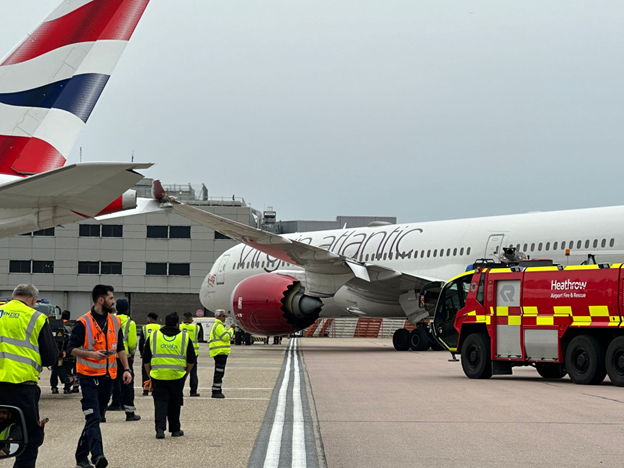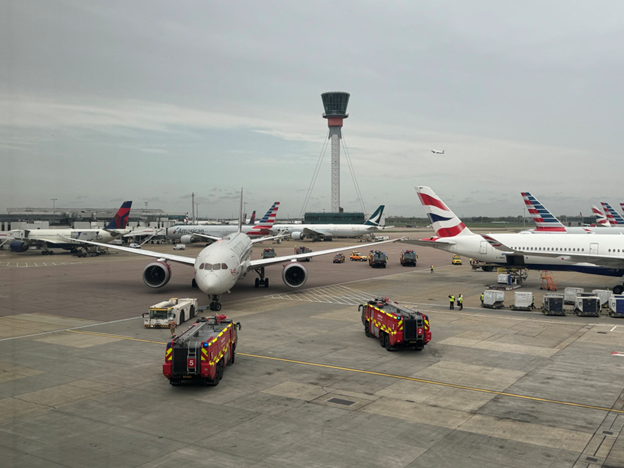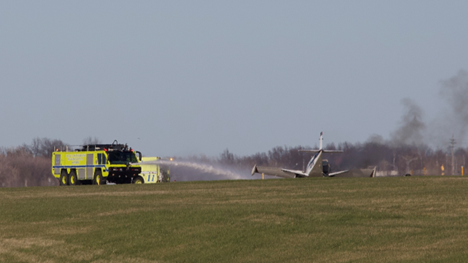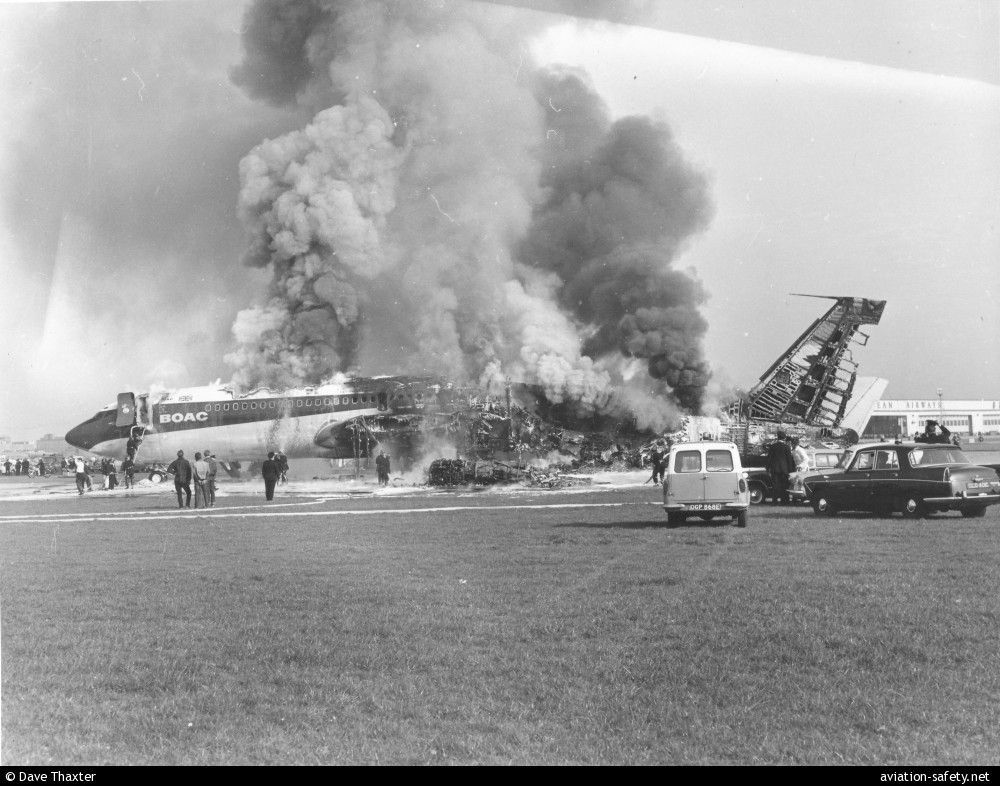ARFF Daily News
Published on:
Monday the 8th of April, 2024
Two passenger planes crash on Heathrow tarmac sparking massive emergency response
Virgin has revealed how the accident unfolded
Two passenger planes have crashed on the tarmac at Heathrow - sparking a massive emergency response.
An empty Virgin Atlantic plane collided with a British Airways jet while being towed at Terminal 3, a Virgin spokesperson confirmed.
Witnesses said the Virgin jet was being pushed back by a tug when its wing clipped the BA plane's tail.
No one was on board the Virgin plane, the spokesperson added.
Dramatic snaps show emergency service vehicles scrambling to the chaotic scene.
The Virgin 787 jet had just landed and was being towed to a different part of the airport.
The accident has not disrupted Virgin's flight schedule from Heathrow.
In a statement, Virgin said: "The wingtip of one of our empty aircraft came into contact with another aircraft while being towed from the stand at London Heathrow Terminal 3.
"The safety of our customers and crew is always our top priority.
"We can confirm no customers were on board the Virgin Atlantic aircraft during this time.
"We’ve commenced a full and thorough investigation.
"Our engineering teams are performing maintenance checks on the aircraft, which for now has been taken out of service."
BA said: "One of our aircraft, whilst stationary at Heathrow earlier today, was involved in a collision with another airline's jet, which was being towed from a stand at the time.
"Our aircraft is being assessed by our engineering teams.
"We have provided an alternative aircraft to limit the impact on our customers."
A Heathrow spokesperson said: "We are working alongside emergency services and our airline partners in response to an incident involving two aircraft on the ground earlier today.
"At present, no passenger injuries have been reported and we do not anticipate there to be any ongoing impact to airport operations."
Witnesses took to social media to express their disbelief over the accidental crash.
Posting on Twitter, Alex Whittles said: "Just witnessed a plane crash at Heathrow!
"A tug pushing back a Virgin 787, crashed the wing into a BA A350."
Heathrow and BA have been contacted for comment.
It comes after around 70 flights to and from UK airports were cancelled as Storm Kathleen buffeted the west coast this morning.
The Atlantic storm has sparked travel delays, power cuts and life-threatening debris along the west coast from Cornwall to Scotland.


Video Shows Boeing Jet Make Emergency Landing After Engine Cover Tears Apart
A flight bound for Houston made an emergency landing Sunday after the plane’s engine cover tore apart, the New York Post reported.
A Southwest Airlines flight en route to Houston from Denver made an emergency landing after a mid-air scare when an engine component disintegrated, according to the New York Post. Southwest’s Flight 3695 turned back minutes after takeoff when its crew noticed part of the engine’s casing had come off. A video shared by ABC’s Sam Sweeney on X shows the engine cover coming loose and flapping in the wind.
The Federal Aviation Administration (FAA) clarified that the dislodged part was an engine cowling, which, after breaking away, impacted the aircraft’s wing flap. The immediate response by the flight crew ensured a safe return to Denver, with the aircraft landing without further incident only 25 minutes post-departure, the New York Post reported.
Southwest Airlines addressed the mishap and attributed it to a mechanical issue with the Boeing 737-800, which records indicate was built in 2017.
“Our Customers will arrive at Houston Hobby on another aircraft, approximately three hours behind schedule,” a Southwest spokesperson told the New York Post. “We apologize for the inconvenience of their delay, but place our highest priority on ultimate Safety for our Customers and Employees. Our Maintenance teams are reviewing the aircraft.”
This recent scare is part of a series of events that have cast a shadow over Boeing. Earlier, an Alaska Airlines Boeing 737-9 Max had to make an emergency landing after losing a door plug mid-flight, leaving a large hole in the plane’s body, the New York Post reported. The Justice Department’s criminal investigation into a mid-flight incident last January and a major lawsuit over safety have put Boeing under more scrutiny, which showcased systemic issues within Boeing.
The company has also faced other adverse incidents, including a runway mishap in Houston and a perilous nosedive involving a New Zealand-bound flight, resulting in injuries to dozens, according to the New York Post.
https://dailycaller.com/2024/04/08/video-boeing-jet-emergency-landing-engine-cover-tears-apart-southwest-airlines/

Small plane crash injures 1 at Hopkins
by: Peggy Gallek, Ed Gallek, Laura Morrison
CLEVELAND (WJW) — The FOX 8 I-TEAM has learned a fire involving single-engine plane injured one person and air traffic disrupted at Cleveland Hopkins International Airport.
The incident happened shortly after 6 p.m. Saturday and left about five planes diverted and seven grounded.
We’ve learned a single-engine plane had an issue while landing, and the engine then caught fire on a runway. Ohio State Highway Patrol later said “the plane touched downed onto the runway, bounced back up, then nosed-dived and crashed.”
A local photographer was out shooting photos at the time of the incident and shared the following snapshots with FOX 8 News:
There were two people inside the plane, according to OSHP and a 64-year-old man was taken to MetroHealth Medical Center for non-life threatening injuries. A 62-year-old woman was not injured.
Hopkins did close the airfield for about an hour as a a result of the incident while airport firefighters put out the fire. They have since reopened, but the airport said it would take some time for “operations to return to normal.”
OSHP said an investigation is ongoing by the Federal Aviation Administration but that impairment is not believed to be involved.
https://fox8.com/news/plane-fire-at-hopkins-airport-disrupts-air-traffic/

Robinson R-44 helicopter crashes into water off Key Biscayne
Andrea Torres, Digital Journalist and Cody Weddle , Reporter
KEY BISCAYNE, Fla. – A Robinson R-44, a four-seat light helicopter, crashed into the water on Saturday afternoon near Key Biscayne.
According to The Federal Aviation Administration, the pilot, who was alone, reported engine issues before crashing at about 1:50 p.m. According to the National Transportation Safety Board, the Robinson R44 helicopter crashed off the Bill Baggs Cape Florida State Park.
Sheridan Flynn shared a photo of a partially submerged helicopter on the X platform.
“Just witnessed a helicopter crash into water just off Key Biscayne,” Flynn wrote on X. “Hope the occupants got out OK.”
Some beachgoers at Bill Baggs Cape Florida State Park reported hearing a loud noise. Apartment residents with water views off Crandon Park said they saw fire rescue and police officers.
“Looked like the chopper had been flying low and very close to the water just prior to the crash,” Flynn wrote on X. “Emergency services and civilian watercraft responded extremely quickly.”
A police marine unit reported rescuing the pilot, according to fire rescue scanner traffic. Miami-Dade Fire Rescue personnel reported the pilot suffered minor injuries and did not need to go to the hospital.
The FAA and the NTSB were set to investigate the crash.
This is a developing story. Local 10 News Assignment Desk Editor Joyce Grace Ortega contributed to this report.

Plane misses part of runway at Ellington Airport
A plane missed part of the runway at an airport in Ellington on Sunday morning and no injuries were reported.
The Federal Aviation Administration said a single-engine Cessna 208 landed short of the runway at Ellington Airport around 11:20 a.m.
A fire official said seven people were on board at the time of the incident.
No injuries were reported and nobody required medical attention.
The FAA is investigating the incident. The Connecticut Airport Authority has also been notified.
https://www.nbcconnecticut.com/news/local/plane-makes-hard-landing-at-ellington-airport/3260095/

NTSB Prelim: Glasair Sportsman 2+2
Engine Stopped Producing Power And The Pilot Performed A Forced Landing To A Field
Location: Fort Meade, FL Accident Number: ERA24LA144
Date & Time: March 14, 2024, 14:42 Local Registration: N76TG
Aircraft: Glasair Sportsman 2+2 Injuries: 2 Minor
Flight Conducted Under: Part 91: General aviation - Personal
On March 14, 2024, at 1442 eastern daylight time, an experimental amateur-built Glasair Sportsman 2+2, N76TG, was destroyed when it was involved in an accident near Fort Meade, Florida. The pilot and passenger were not injured. The airplane was operated as a Title 14 Code of Federal Regulations Part 91 personal flight.
According to the pilot, he and his passenger departed Lakeland Linder International Airport (LAL), Lakeland, Florida, at 1430 to return to Fly In Ranches Airport (FD25), Vero Beach, Florida. About 30 minutes into the flight, smoke entered the cockpit and the engine noise changed. Shortly thereafter, the engine stopped producing power and the pilot performed a forced landing to a field. During the landing, the airplane’s nose landing gear dug into the ground and the airplane nosed over. The pilot and passenger egressed from the airplane and the airplane was then consumed by fire.
Postaccident examination of the wreckage by a Federal Aviation Administration inspector revealed that the exhaust pipe was missing. The wreckage was retained for further examination.
FMI: www.ntsb.gov
NTSB Prelim: Enstrom Helicopter Corp 280C
Pilot Reported That He Was Repositioning The Helicopter From His Front Yard To A Moveable Landing Platform
Location: Port Lavaca, TX Accident Number: CEN24LA137
Date & Time: March 16, 2024, 16:45 Local Registration: N280WR
Aircraft: Enstrom Helicopter Corp 280C Injuries: 1 None
Flight Conducted Under: Part 91: General aviation - Personal
On March 16, 2024, about 1645 central daylight time, an Enstrom 280C Helicopter, N280WR, was substantially damaged when it was involved in an accident near Port Lavaca, Texas. The pilot was not injured. The helicopter was operated as a Title 14 Code of Federal Regulations Part 91 personal flight.
The pilot reported that he was repositioning the helicopter from his front yard to a moveable landing platform. While he was hovering over the platform the helicopter lost engine power and settled with the right skid on the platform and the helicopter rolled to the left resulting in the rotor blades contacting the ground. During the accident sequence, the main rotor, tail rotor, tail boom and stabilizers were substantially damaged.
The helicopter was recovered to a secure location. A post-accident examination is planned.
FMI: www.ntsb.gov
NTSB Prelim: Beech A36
Engine Seized And The Pilot Made A Forced Landing To A Rural Road
Location: Blackshear, GA Accident Number: ERA24LA143
Date & Time: March 17, 2024, 08:25 Local Registration: N729CW
Aircraft: Beech A36 Injuries: 3 None
Flight Conducted Under: Part 91: General aviation - Personal
On March 17, 2024, at 0825 eastern daylight time, a Beech A36 single-engine airplane, N729CW, was substantially damaged when it was involved in an accident near Blackshear, Georgia. The private pilot and the two passengers were not injured. The airplane was operated as a Title 14 Code of Federal Regulations Part 91 personal flight.
The airplane departed Jacksonville International Airport (JAX), Jacksonville, Florida, at 0753, and was destined for Wood County Airport (1G0), Bowling Green, Ohio, on an instrument flight rules (IFR) flight plan. The pilot stated that the airplane was climbing through 11,000 ft mean sea level (msl) to 13,000 ft msl, when he noticed a reduction in engine power and inability to climb. Moments later the engine oil pressure began to drop, the engine then began to run rough and make “loud banging noises.” The engine seized and the pilot made a forced landing to a rural road. The airplane impacted a tree resulting in substantial damage to the right wing and engine mounts.
The airframe and engine were retained for further examination.
FMI: www.ntsb.gov

Today in History
56 Years ago today: On 8 April 1968 a BOAC Boeing 707 suffered engine fire and returned to Heathrow on fire for an emergency landing, killing 5 out of 127 occupants.
Date: Monday 8 April 1968
Time: 15:35
Type:
Boeing 707-465
Owner/operator: British Overseas Airways Corporation - BOAC
Registration: G-ARWE
MSN: 18373/302
Year of manufacture: 1962
Total airframe hrs: 20870 hours
Engine model: Rolls-Royce Conway 508
Fatalities: Fatalities: 5 / Occupants: 127
Aircraft damage: Destroyed, written off
Category: Accident
Location: London-Heathrow Airport (LHR) - United Kingdom
Phase: Initial climb
Nature: Passenger - Scheduled
Departure airport: London-Heathrow Airport (LHR/EGLL)
Destination airport: Zürich-Kloten Airport (ZRH/LSZH)
Confidence Rating: Accident investigation report completed and information captured
Narrative:
The aircraft was operating Flight BA 712 from London-Heathrow Airport to Zürich and Sydney. A check pilot was on the aircraft for the purpose of carrying out a route check on the pilot-in-command. The aircraft became airborne from runway 28L at 15:27 and 20 seconds later, just before the time for the noise abatement power reduction, the flight crew felt and heard a combined shock and bang. The thrust lever for the No. 2 engine "kicked" towards the closed position and at the same time the instruments showed that the engine was running down. The captain ordered the engine failure drill. Because the undercarriage was retracted, the warning horn sounded when the flight engineer fully retarded the thrust lever; the check pilot and flight-engineer simultaneously went for and pulled the horn cancel switch on the pedestal whilst the co-pilot instinctively but in error pressed the fire bell cancel button. In front of him the flight-engineer went for the engine fire shut-off handle but he did not pull it. The check pilot then reported seeing a serious fire in the No. 2 engine. Having initially started an engine failure drill, the flight engineer changed directly to the engine fire drill. ATC originally offered the pilot-in-command a landing back on runway 28L and alerted the fire services but after a "Mayday" call Flight 712 was offered runway 05R which was accepted as it would result in a shorter flight path. About 1,5 minutes after the start of the fire, No. 2 engine, together with part of its pylon, became detached and fell into a waterfilled gravel pit. At about the time the engine fell away the undercarriage was lowered and full flap selected. The undercarriage locked down normally but the hydraulic pressure and contents were seen to fall and the flaps stopped extending at 47deg, that is 3deg short of their full range. The approach to runway 05R was made from a difficult position, the aircraft being close to the runway and having reached a height of about 3000 feet and a speed of 225 kt. There is no glide slope guidance to this runway but the approach was well judged and touchdown was achieved approximately 400 yards beyond the threshold. The aircraft came to a stop just to the left of the runway centre line, about 1800 yards from the threshold.
After the aircraft came to rest the flight engineer commenced the engine shut-down drill and closed the start levers. Almost simultaneously the pilot-in-command ordered fire drill on the remaining engines. Before this could be carried out there was an explosion from the port wing which increased the intensity of the fire and blew fragments of the wing over to the starboard side of the aircraft. The pilot-in-command then ordered immediate evacuation of the flight deck. The engine fire shut-off handles were not pulled and the fuel booster pumps and main electrical supply were not switched off. There were more explosions and fuel, which was released from the port tanks, spread underneath the aircraft and greatly enlarged the area of the fire. The cabin crew had made preparations for an emergency landing and as the aircraft came to a stop opened the emergency exits and started rigging the escape chutes. The passengers commenced evacuation from the two starboard overwing exits and shortly afterwards, when the escape chutes had been inflated, from the rear starboard galley door and then the forward starboard galley door. However, because of the spread of the fire under the rear of the fuselage the escape chute at the rear galley door soon burst and, following the first explosion, the overwing escape route also became unusable. The great majority of the survivors left the aircraft via the forward galley door escape chute.
PROBABLE CAUSE: "The accident resulted from an omission to close the fuel shut off valve when No. 2 engine caught fire following the failure of its No. 5 low pressure compressor wheel. The failure of the wheel was due to fatigue."


Mailing Address
Subscribe to our newsletter
Contact Us
We will get back to you as soon as possible.
Please try again later.
